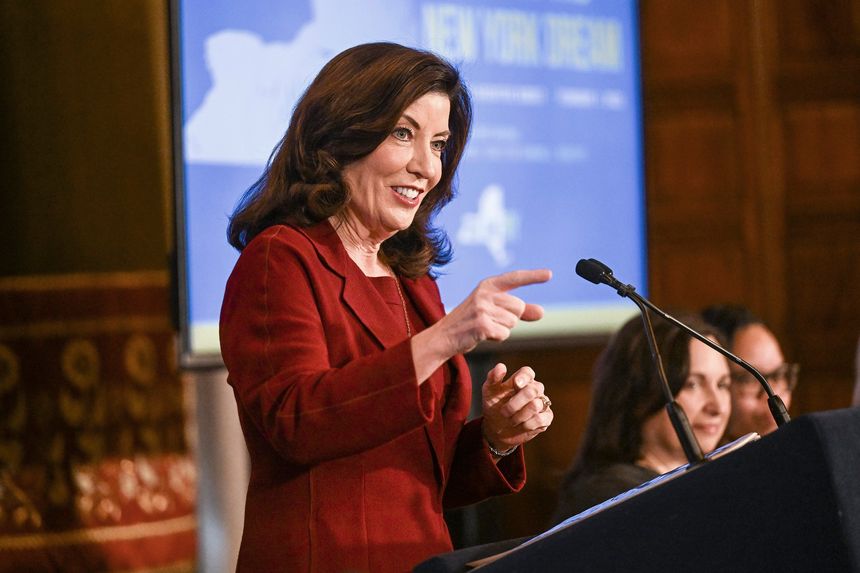
New York Gov. Kathy Hochul presents her executive state budget at the state Capitol in Albany on Feb. 1.
Photo:
Hans Pennink/Associated Press
New York is bleeding taxpayers and business, so how does Gov.
Kathy Hochul
open her first legislative year? By proposing to raise taxes some more. That’s the economic news buried in the $227 billion budget she unveiled this week that includes a higher payroll tax plus a new CO2 cap-and-trade program.
The Governor is directing state officials to develop an economy-wide carbon trading system that will force businesses to pay for their CO2 emissions. This is a stealth tax increase. The state will establish a cap on statewide emissions that will decline over time to reduce emissions to 40% below 1990 levels by 2030 and 85% by 2050. The state will auction allowances to fuel distributors, utilities, manufacturers and other businesses to offset their CO2 emissions.
Allowance prices will increase over time as the cap declines, meaning businesses will have to slash their emissions or pay more to offset them. Ms. Hochul seems to think the program will prod businesses to electrify operations and reduce fossil-fuel consumption. She fails to consider that many can’t.
Natural gas accounts for 45% of the state’s electricity and will continue to be needed to balance intermittent wind power. Utilities and other companies will have to buy credits at increasing cost and then pass the cost to customers. The result will be higher energy costs across the board.
Ms. Hochul tacitly concedes this by proposing to steer 35% of auction revenue to climate programs for poor neighborhoods. Most would probably prefer lower energy bills to having, say, an electric-vehicle charging station on their block. She also wants to cap electric bills at 6% of income for households that replace gas appliances. We told you the war on gas stoves is real.
New York companies and workers will pay for all this. Europe’s cap-and-trade program has made its manufacturers less competitive, so the European Union is planning to implement a carbon tariff on imports to level the playing field. A New York carbon border tax would violate the Constitution’s Commerce Clause.
Ms. Hochul is directing state officials to “design a cost-mitigation program to ensure New York industries are not put at a competitive disadvantage.” But the very point of cap-and-trade is to impose costs to compel businesses to shift from fossil fuels—no matter if it’s cost-effective or even technologically feasible.
New York’s cap-and-trade model is California, where CO2 allowance prices have climbed by nearly two-thirds over the last three years and are driving up energy costs. While California’s cap-and-trade program has reduced oil production in the state, its CO2 reductions have been overwhelmed by wildfires.
California Democrats have used the $4 billion in annual cap-and-trade auction revenue to subsidize electric vehicles and solar panels for the wealthy. The dirty little secret that California and Ms. Hochul won’t share with voters is that cap and trade is a regressive tax that punishes low- and middle-income earners.
The same goes for Ms. Hochul’s proposal to raise a payroll tax on business to 0.5% from 0.34% to bail out the Metropolitan Transportation Authority, which has lost ridership owing to subway crime and workers fleeing New York City. Businesses will pass the payroll tax increase onto workers.
The MTA received more than $15 billion in federal funds from the infrastructure and Covid bills, yet it’s still in the red. Ms. Hochul proposes no labor reforms to make the MTA more efficient.
Her budget would also extend a 0.75 percentage-point increase in the corporate franchise tax on businesses with incomes of more than $5 million. The state enacted this tax increase in 2021, and it was supposed to lapse at the end of this year. But Ms. Hochul wants to extend it three years even though the state has an $8.7 billion budget surplus.
Albany Democrats live in a progressive bubble and behave as if taxes and the cost of living don’t matter. No wonder so many non-crazy New Yorkers now live in Miami.
Copyright ©2022 Dow Jones & Company, Inc. All Rights Reserved. 87990cbe856818d5eddac44c7b1cdeb8
Appeared in the February 3, 2023, print edition.












